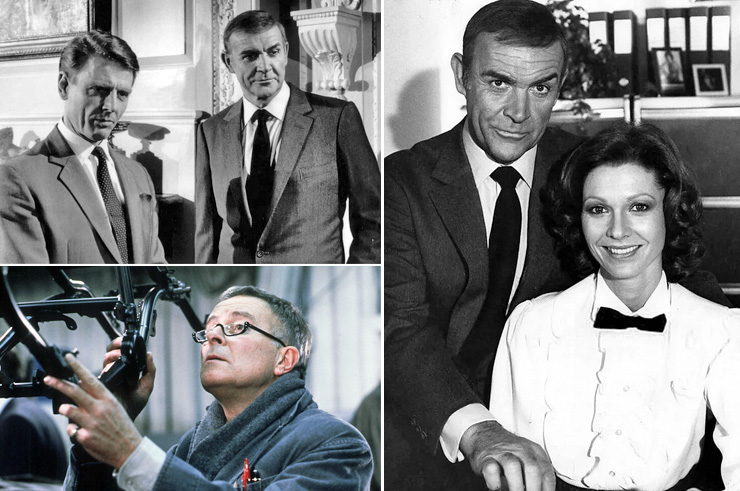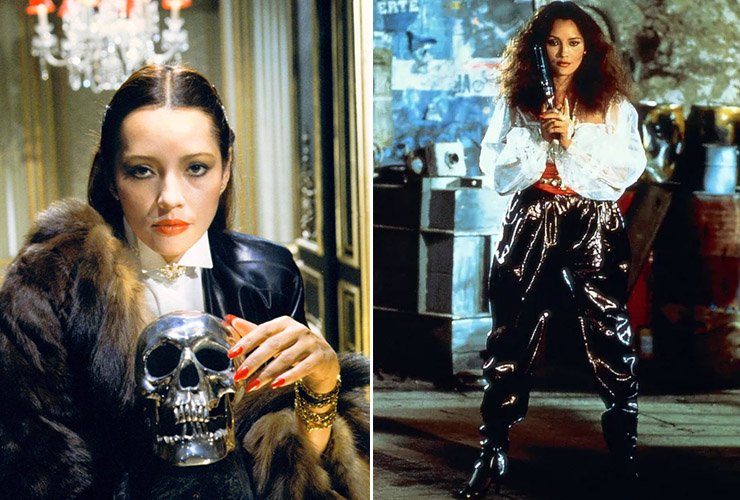|
The Bond ‘regulars’ – M,
Q, and Miss Moneypenny also had to be cast to rival roles that were
defined by Bernard Lee,
Desmond Llewelyn, and
Lois Maxwell respectively.
The distinguished stage actor Edward Fox, who enjoyed international
stardom after appearing in the 1973 film The Day of The Jackal was
cast as M. Fox claimed he was a Fleming fan, and prior to playing M, had
read all the Ian Fleming novels. Sean Connery commented upon the choice of
Edward Fox, “He’s exactly right as the clinical computerised Englishman.
We have to believe Bond has moved with the times and Edward was a first
choice to contrast with the grey type character Fleming created played by
old Bernie [Bernard Lee (1908-1981)].” The role of Q, or Algernon as the
character is oddly referred to in Never Say Never Again, was
portrayed quirkily by Alec McCowen (1925-2017). Shortly before his death
Desmond Llewelyn said that he very much enjoyed McCowen’s portrayal of Q,
finding him very funny. Miss Moneypenny was played by
Pamela Salem, who told 007
MAGAZINE in 1984, “I had seen Moneypenny before of course in the
earlier films played by Lois Maxwell, at first they [the media] tried to
stir things up between us, it was absolute nonsense and Lois did write me
a very nice letter.” |
 |
|
ABOVE: THE OLD GUARD
(top left) Edward Fox as M with Sean Connery as James Bond,
(right) Sean Connery with Pamela Salem as Moneypenny, and (bottom
left) Alec McCowen at Q (Algernon) in Never Say Never Again
(1983). |
|
|
|
Bernie Casey was cast as
the first black actor ever to play Bond’s CIA ally Felix Leiter.
Peter Janson-Smith of Glidrose, the agency handling the rights to the Ian
Fleming novels told the Sunday Mirror on November 28, 1982, “It’s
extraordinary to change Leiter’s colour. It’s like saying James Bond
himself might be a black man. We are very concerned about the misuse of
any of the characters.” He was also quick to point out that Fleming
described Leiter in the novel CASINO ROYALE as having a mop of straw
coloured hair. Jack Schwartzman defended his choice, “Both Sean and I
thought it might be a good idea to have a black actor play Felix, and
Bernie is perfect. It was never specified that Felix was not black.”
Janson-Smith continued, “I would like to know how many black men there are
with a mop of straw coloured hair?” Casey revealed an interesting
conversation he had with Sean Connery during pre-production, “He (Connery)
said Felix Leiter had been in all the Bond films he’s made, and I said
‘Really?’ He said since Felix Leiter is not memorable; let’s make him
black, and at least that will make him more noticeable and therefore more
memorable. It changes nothing in the texture of the story. I think it’s a
nice move.” |
 |
|
Credited only as ‘Lady in
the Bahamas’, former Hammer horror star Valerie Leon has earned the
achievement of appearing in three James Bond films,
Casino Royale
(1967), The Spy Who Loved Me (1977), and Never Say Never Again
(1983). But what makes her achievement most notable is that different
production companies made all three films! It’s interesting to note that
Sean Connery even considered a cameo performance for his favourite co-star
Ursula Andress. He commented, “A cameo role would have been nice, but then
you start getting into dangerous water.” He even thought of asking Roger
Moore to make a brief appearance in the final scene, “I thought it would
be great to have me walking down the street with Domino and have Roger wag
an accusing finger and saying ‘Never!’’’ |
 |
On September 27, 1982,
with a script and cast in place, Schwartzman, Kershner, and Connery, were
able to begin rolling the cameras on the James Bond movie that nobody
believed would ever be made. Cubby Broccoli,
Michael G. Wilson, and
director John Glen, were simultaneously hard at work with Roger Moore on
Octopussy on location in India, Germany, and of course Pinewood
Studios. The press were adamant to stir up rivalry between the two Bond
stars, and headlines soon heralded ‘The Battle of The Bonds.’ Connery was
adamant that before shooting that any rivalry was dismissed. Andrew Yule,
in his book Sean Connery: Neither Shaken Nor Stirred, commented
that Sean had suggested that Roger and himself pose for a photograph
together and issue a joint statement. Although photographs of the two
James Bonds were taken the statement was never issued. Roger Moore didn’t
seem bothered by the attention, “Does John Gielgud complain because
Laurence Olivier is playing Hamlet at the same time?” |
|
|
In the last of the summer
sunshine, Kershner, with the aid of his largely British crew, began to
capture Connery on celluloid as 007 for the first time in 12 years. Based
in Nice, the production was to utilise many locations on the French
Riviera. While the main unit shot the casino sequence in Monte Carlo,
Schwartzman dispatched the Second Unit to shoot the motorbike chase, which
was filmed at various Riviera locales, from Cap Antibes to Menton. The
sequence consisted of 007 chasing Fatima Blush, who is escaping in a
striking red Renault 5 Turbo. Carrera said of her role, “For this film I
had to do things I never imagined I’d do. I have a fear of deep water, yet
I did scuba diving. I’m not fond of snakes, yet I allowed myself to be
kissed by a boa constrictor. I had to drive with a manual gearbox – I
didn’t quite learn that one.” Her then husband and agent, Nicholas
Mavroleon, who was with Carrera for most of the shoot added, “Barbara ran
through three Renault gearboxes trying.” |
 |
|
Irvin Kershner was aided
by a fantastic array of British film technicians, including his Director
of Photography Douglas Slocombe, one of the most distinguished
cinematographers in the business. His career has included many highly
acclaimed films, among which he has received two Academy Award
nominations, for Raiders of The Lost Ark (1981), and Travels
With My Aunt (1972), and BAFTA awards for The Servant (1963)
and Julia (1977). Filming continued in and around Nice for most of autumn.
In the ancient fishing village of Villefranche, the Citadelle doubled as
the exterior of ‘Palmyra’, Maximillian Largo’s retreat. The locals were
absolutely amazed to witness the biggest and most expensive yacht of its
time sail into their tiny harbour. The ‘Nabila’, the floating palace of
Saudi Arabian billionaire Adnan Khashoggi (1935-2017), doubled for Largo’s
yacht ‘The Flying Saucer’.
Sean Connery was
concerned about how to approach James Bond, a character he hadn’t played
in over a decade, “I was totally open about how he should look. I thought
about not having the hair-piece, of adding a moustache or a beard, but
decided to let him be just as he was before – but at the age of 53.” He
continued, “I did consider making him really over the hill. We thought
about Bond preparing to get into bed with a woman, taking vitamin C pills
and doing his press-ups in preparation. That would have been funny, but if
you weighed up the laughs against the kind of picture you’d make, you’d
end up with a parody, with a man who is less than he should be.” |
|
CONTINUED |
|
|
|
|


